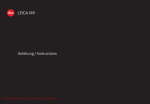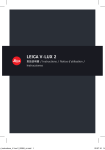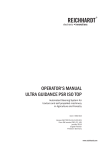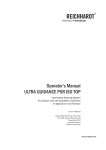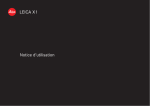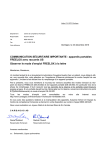Download Leica V-LUX 20 Instruction Manual
Transcript
LEICA V - LUX 20 Instructions Dear Customer, We would like to take this opportunity to thank you for purchasing this LEICA V-LUX 20. Please read these instructions carefully and keep them handy for future reference. Carefully observe copyright laws ••Recording of pre-recorded tapes or discs or other published or broadcast material for purposes other than your own private use may infringe copyright laws. Even for the purpose of private use, recording of certain material may be restricted. Information for Your Safety To reduce the risk of fire, burns, or shock hazard and annoying interference: ••Use only the recommended accessories. ••Do not expose this equipment to rain or moisture, dripping or splashing water and make sure no objects filled with liquids such as vases are placed on the equipment. ••Do not expose to heat above 60 °C (140 °F). ••Do not remove the cover (back): there are no user serviceable parts inside. Refer servicing to your Leica dealer, an authorized Leica service station / the Leica distributer in your country (for addresses, see Warranty Card), or the Leica Customer Service department (for address (→29)). ••The mains outlet must be located near the connected equipment and it must be easily accessible. The product identification marking is located on the bottom of the camera. ■■About the battery pack CAUTION Battery pack (Lithium ion battery pack) ••Use the specified unit to recharge the battery pack. ••Do not use the battery pack with equipment other than the specified unit. ••Do not get dirt, sand, liquids, or other foreign matter on the terminals. ••Do not touch the plug terminals (+ and −) with metal objects. ••Do not disassemble, remodel, heat or throw into fire. If any electrolyte should come into contact with your hands or clothes, wash it off thoroughly with water. If any electrolyte should come into contact with your eyes, never rub the eyes. Rinse eyes thoroughly with water, and then consult a doctor. CAUTION Danger of explosion if battery is incorrectly replaced. Replace only with the same or equivalent type recommended by Leica Camera AG (→9). Dispose of used batteries according to the instructions (→7). ••Do not heat or expose to flame. ••Do not leave the battery(ies) in an automobile exposed to direct sunlight for a long period of time with doors and windows closed. Warning Risk of fire, explosion and burns. Do not disassemble, heat above 60 °C (140 °F) or incinerate. (U.S. only) A recyclable lithium ion/polymer battery powers the product you have purchased. Please call 1-800-8-BATTERY for information on how to recycle this battery. This Class B digital apparatus complies with Canadian ICES-003 2 3 FCC Note: (U.S. only) This equipment has been tested and found to comply with the limits for a Class B digital device, pursuant to Part 15 of the FCC Rules. These limits are designed to provide reasonable protection against harmful interference in a residential installation. This equipment generates, uses, and can radiate radio frequency energy and, if not installed and used in accordance with the instructions, may cause harmful interference to radio communications. However, there is no guarantee that interference will not occur in a particular installation. If this equipment does cause harmful interference to radio or television reception, which can be determined by turning the equipment off and on, the user is encouraged to try to correct the interference by one or more of the following measures: •• Reorient or relocate the receiving antenna. •• Increase the separation between the equipment and receiver. •• Connect the equipment into an outlet on a circuit different from that to which the receiver is connected. •• Consult the dealer or an experienced radio/TV technician for help. FCC Caution: To assure continued compliance, follow the attached installation instructions and use only shielded interface cables with ferrite core when connecting to computer or peripheral devices. Any changes or modifications not expressly approved by the party responsible for compliance could void the user’s authority to operate this equipment. Declaration of Conformity Trade Name: Leica Model No.: LEICA V-LUX 20 Responsible party/ Support contact:Leica Camera Inc. 1 Pearl Court, Unit A Allendale, New Jersey 07401 Tel.: +1 201 995 0051 232 Fax: +1 201 995 1684 e-mail: [email protected] This device complies with Part 15 of the FCC Rules. Operation is subject to the following two conditions: (1) This device may not cause harmful interference, and (2) this device must accept any interference received, including interference that may cause undesired operation. 4 LEICA V-LUX 20 (U.K. only) Caution for AC mains lead For your safety, please read the following text carefully. This appliance is supplied with a moulded three pin mains plug for your safety and convenience. A 5-ampere fuse is fitted in this plug. Should the fuse need to be replaced please ensure that the replacement fuse has a rating of 5-ampere and that it is approved by ASTA or BSI to BS1362. Check for the ASTA mark or the BSI mark on the body of the fuse. If the plug contains a removable fuse cover you must ensure that it is refitted when the fuse is replaced. If you lose the fuse cover the plug must not be used until a replacement cover is obtained. A replacement fuse cover can be purchased from your local dealer. CAUTION! IF THE FITTED MOULDED PLUG IS UNSUITABLE FOR THE SOCKET OUTLET IN YOUR HOME THEN THE FUSE SHOULD BE REMOVED AND THE PLUG CUT OFF AND DISPOSED OF SAFELY. THERE IS A DANGER OF SEVERE ELECTRICAL SHOCK IF THE CUT OFF PLUG IS INSERTED INTO ANY 13- AMPERE SOCKET. If a new plug is to be fitted please observe the wiring code as stated below. If in any doubt please consult a qualified electrician. ■■IMPORTANT The wires in this mains lead are coloured in accordance with the following code: Blue: Neutral, Brown: Live. As these colours may not correspond with the coloured markings identifying the terminals in your plug, proceed as follows: The wire which is coloured Blue must be connected to the terminal which is marked with the letter N or coloured Black or Blue. The wire which is coloured Brown must be connected to the terminal which is marked with the letter L or coloured Brown or Red. WARNING: DO NOT CONNECT EITHER WIRE TO THE EARTH TERMINAL WHICH IS MARKED WITH THE LETTER E, BY THE EARTH SYMBOL OR COLOURED GREEN OR GREEN/YELLOW. THIS PLUG IS NOT WATERPROOF KEEP DRY. ■■Before use Remove the connector cover. ■■How to replace the fuse The location of the fuse differ according to the type of AC mains plug (figures A and B). Confirm the AC mains plug fitted and follow the instructions below. Illustrations may differ from actual AC mains plug. 1. O pen the fuse cover with a screwdriver. Figure A Figure B Fuse cover 2. R eplace the fuse and close or attach the fuse cover. Figure A Figure B Fuse (5 ampere) Fuse (5 ampere) 5 ■■About the battery charger CAUTION! •• DO NOT INSTALL OR PLACE THE CHARGER IN A BOOKCASE, BUILTIN CABINET OR IN ANOTHER CONFINED SPACE. ENSURE IT IS WELL VENTILATED. TO PREVENT RISK OF ELECTRIC SHOCK OR FIRE HAZARD DUE TO OVERHEATING, ENSURE THAT CURTAINS AND ANY OTHER MATERIALS DO NOT OBSTRUCT THE VENTILATION VENTS. •• DO NOT OBSTRUCT THE CHARGER’S VENTILATION OPENINGS WITH NEWSPAPERS, TABLECLOTHS, CURTAINS, AND SIMILAR ITEMS. •• DO NOT PLACE SOURCES OF NAKED FLAMES, SUCH AS LIGHTED CANDLES, ON THE CHARGER. •• DISPOSE OF BATTERIES IN AN ENVIRONMENTALLY FRIENDLY MANNER. Battery charger This battery charger operates on AC between 110 V and 240 V. But ••In the U.S.A. and Canada, the battery charger must be connected to a 120 V AC power supply only. ••When connecting to an AC supply outside of the U.S.A. or Canada, use a plug adapter to suit the AC outlet configuration. •• The battery charger is in the standby condition when it is connected. The primary circuit is always “live” as long as the battery charger is connected to an electrical outlet. ■■Cautions for Use •• Do not use any other AV cables except the supplied one. •• Do not use any other USB connection cables except the supplied one. •• Do not use any other HDMI cable except the genuine Leica HDMI mini cable (optional, →9). Keep the camera as far away as possible from electromagnetic equipment (such as microwave ovens, TVs, video games etc.). •• If you use the camera on top of or near a TV, the pictures and sound on the camera may be disrupted by electromagnetic wave radiation. •• Do not use the camera near cell phones because doing so may result in noise adversely affecting the pictures and sound. •• Recorded data may be damaged, or pictures may be distorted, by strong magnetic fields created by speakers or large motors. •• Electromagnetic wave radiation generated by microprocessors may adversely affect the camera, disturbing the pictures and sound. •• If the camera is adversely affected by electromagnetic equipment and stops functioning properly, turn the camera off and remove the battery. Then reinsert the battery and turn the camera on. Information for Users on Collection and Disposal of Old Equipment and used Batteries These symbols on the products, packaging, and/or accompanying documents mean that used electrical and electronic products and batteries should not be mixed with general household waste. For proper treatment, recovery and recycling of old products and used batteries, please take them to applicable collection points, in accordance with your national legislation and the Directives 2002/96/EC and 2006/66/EC. By disposing of these products and batteries correctly, you will help to save valuable resources and prevent any potential negative effects on human health and the environment which could otherwise arise from inappropriate waste handling. For more information about collection and recycling of old products and batteries, please contact your local municipality, your waste disposal service or the point of sale where you purchased the items. Penalties may be applicable for incorrect disposal of this waste, in accordance with national legislation. For business users in the European Union If you wish to discard electrical and electronic equipment, please contact your dealer or supplier for further information. [Information on Disposal in other Countries outside the European Union] These symbols are only valid in the European Union. If you wish to discard these items, please contact your local authorities or dealer and ask for the correct method of disposal. Note for the battery symbol (bottom two symbol examples): This symbol might be used in combination with a chemical symbol. In this case it complies with the requirement set by the Directive for the chemical involved. Cd Do not use the camera near radio transmitters or high-voltage lines. •• If you record near radio transmitters or high-voltage lines, the recorded pictures and sound may be adversely affected. 6 7 Contents Scope of delivery Accessories Information for Your Safety........2 Rechargeable battery BP-DC7-U BP-DC7-E Battery charger BC-DC7-U BC-DC7-E Mains cable EU/AS UK J AUS TW Before use Scope of delivery.........................9 Accessories.................................9 Names of parts..........................10 Cursor button.................................. 11 Basics Selecting the [REC] mode.........19 For taking pictures with extended automatic settings [SNAPSHOT MODE]..................20 AF Tracking.....................................21 Preparations Charging the battery.................12 Inserting and removing the card (optional)/the battery........14 Picture save destination (cards and built-in memory)............15 Setting the Clock.......................16 About GPS......................................17 Setting the menu.......................18 Taking motion pictures.............22 Viewing your pictures [NORMAL PLAY]........................23 Deleting pictures.......................23 Others Using the instructions on the supplied CD-ROM......................24 Technical Data...........................25 Leica Academy..........................28 Leica on the Internet.................28 Leica information service.........29 Leica Customer Service............29 Notice: Please note that the actual controls, components, menu items, menu screen illustrations etc. of your LEICA V-LUX 20 may look somewhat different from those shown in the illustrations in these instructions. 8 Wrist strap CD with instr. PDF DVD with software USB cable AV cable Battery case Button template for Canada / Taiwan Short instructions Warranty Card Order No. 18 702 18 701 423-082.001-010 423-082.001-012 Leather case HDMI mini cable-E Mini tripod Tabletop tripod Ball and Socket head Order No. 18 700 14 491 14 320 14 110 14 100 423-068.801-019 423-068.801-020 423-068.801-022 423-068.801-023 424-025.002-000 (delivery differs depending on markets) 423-082.001-014 423-082.001-016 423-082.001-018 423-082.001-020 423-082.001-022 423-082.001-024 423-082.805-003 (For cameras sold in the U.S., Canada, Taiwan and Japan) 93 289 -295 (delivery differs depending on markets) 439-399.100-026 Notes: ••Cards are optional. You can record or play back pictures on the built-in memory when you are not using a card. ••Check that all items belonging to the scope of delivery are included before using the camera. ••The items and their shape may differ depending on the country or area where the camera was purchased. ••The battery pack is called either battery pack or battery in the text. ••The battery charger is called either battery charger or charger in the text. ••Please dispose of all packaging appropriately (→7). 9 Names of parts The illustrations and screens in this manual may differ from the actual product. Camera ON/OFF switch Cursor button Shutter button Mode dial Flash Self-timer indicator/AF Assist Lamp Lens barrel Lens Speaker Zoom lever GPS antenna Microphone REC/PLAY switch LCD monitor [MENU/SET] (menu display/set/finish) Up cursor button (▲) ••Exposure Compensation Left cursor button (◄) ••Self-timer Right cursor button (►) ••Flash Down cursor button (▼) ••Macro Mode ●●In this manual, the button that is used is shaded or indicated by▲▼◄►. Motion picture button [EXPOSURE] button Status indicator Hand strap eyelet We recommend using the supplied hand strap to avoid dropping the camera. [DISPLAY] button Q.MENU/Delete button Tripod thread ••Ensure that the tripod is stable. Card/Battery door HDMI socket Release lever [AV OUT/DIGITAL] socket ●●We recommend to use a sufficiently charged battery when recording motion pictures. 10 11 Charging the battery ■■About batteries that you can use with this unit Connect the charger to the electrical outlet Use only the dedicated Leica battery (→9) with this camera. It has been found that counterfeit battery packs which look very similar to the genuine products are made available to purchase in some markets. Some of these battery packs are not adequately protected with internal protection to meet the requirements of appropriate safety standards. There is a possibility that these battery packs may lead to fire or explosion. Please be advised that Leica Camera AG is not liable for any accident or failure occurring as a result of use of a counterfeit battery pack. To ensure that safe products are used we recommend to use only the dedicated Leica battery (→9) with this camera. ••Use the dedicated charger and battery. ••The camera has a function for distinguishing batteries which can be used safely. The dedicated Leica battery (→9) supports this function. The only battery suitable for use with this camera is the Leica battery (→9). (Batteries which do not support this function cannot be used). Leica Camera AG cannot in any way guarantee the quality, performance or safety of batteries which have been manufactured by other companies and are not genuine Leica Camera AG products. ••The battery is not charged when the camera is shipped. Charge the battery and set the clock before use. ••Charge the battery with the charger indoors (10 °C - 35 °C (50 °F 95 °F)). Insert the battery into the charger The terminals should face the charger’s contacts and the Leica logo upwards. 12 1 2 Charging light ([CHARGE]) ●●Plug-in type ●●Inlet type On:Charging in progress (approx. 130 min. if fully depleted) Off: Charging complete Detach the battery after charging is completed ■■Guidelines for number of recordable pictures and recording time Number of recordable pictures Recording time Playback time Approx. 300 pictures Approx. 150 min Approx. 300 min Recording conditions by CIPA standard ••CIPA is an abbreviation of [Camera & Imaging Products Association]. ••[PROGRAM AE] Mode. ••[GPS SETTING] is set to [OFF]. ••Temperature: 23 °C (73.4 °F)/Humidity: 50% when LCD monitor is on.∗ ••Using a 32MB SD memory card ••Using the supplied battery. ••Starting recording 30 seconds after the camera is turned on. (When the Optical Image Stabilizer function is set to [AUTO].) ••Recording once every 30 seconds with full flash every second recording. ••Rotating the zoom lever from Tele to Wide or vice versa in every recording. ••Turning the camera off every 10 recordings and leaving it until the temperature of the battery decreases. ∗ The number of recordable pictures decreases when [LCD MODE] is used. 13 Inserting and removing the card (optional)/the battery Set the camera ON/OFF switch to OFF and slide the release lever ( A ) to [OPEN] before opening the lid Completely insert battery and card A Picture save destination (cards and built-in memory) ■■Built-in memory (approx. 15 MB) ●●The built-in memory can be used as a temporary storage device when [OPEN] [LOCK] the card being used becomes full. ●●The access time for the built-in memory may be longer than the access time for a card. ■■Compatible memory cards (optional) ••Battery: Push in until the lever is locked. ••Memory card: Push in until it clicks. The following SD standard-based cards B Do not touch terminals. C Check orientation. Close lid B Slide to the [LOCK] position. C Type of Card Capacity SD memory 8 MB – 2 GB cards SDHC memory 4 GB – 32 GB cards SDXC memory 48 GB – 64 GB cards Notes •• Can be used with devices compatible with the respective formats. •• Before using SDXC memory cards, check that your computer and other devices support this type of card. •• Cards in capacities not listed at left are not supported. Switch (LOCK) ●●If the write-protect switch is set to ‘LOCK’, the card cannot be used to ■■To remove ••To remove battery: move lever in direction of arrow. ••To remove card: press down in center. record or delete pictures, and it cannot be formatted. Lever ●●Use only the dedicated Leica battery (→9). ●●If you use other batteries, we cannot guarantee the quality of this product. ●●The card may be damaged if it is not fully inserted. 14 ●●Keep the Memory Card out of reach of children to prevent swallowing. 15 Setting the Clock The Clock is not set when the camera is shipped. Turn on the power ( A ) A Press [MENU/SET] ( B ) while the message is displayed The current time and home area are set. ••[GPS SETTING] turns [ON]. ••Turn on the power again and check time display. ■■To change time setting Press ▲▼ to select the language, and press [MENU/SET] ••The [PLEASE SET THE CLOCK] message appears. Press ◄► to set your home area and press [MENU/SET] B Select [CLOCK SET] from the [REC] or [SETUP] menu, perform . Press [MENU/SET] Press ◄► to select the items (year, month, day, hour, minute, display order or time display format), and press ▲▼ to set ••To cancel → Press . When GPS is used, the camera performs the following functions: ••Records location name information and the latitude and longitude for the positioned location on the recorded pictures. ••Corrects automatically to the current time. power is off. Confirm the setting and press [MENU/SET] . Press ▲▼ to select [YES] and press [MENU/SET] if automatically correcting time of day ••To manually set date and time →select [NO]. When [PLEASE SET THE HOME AREA] is displayed, press [MENU/SET] 16 About GPS ■■The GPS function can be used even when the camera’s Press [MENU/SET] ••To return to the previous screen, press and When [GPS SETTING] is [ON], the GPS function works to check your current position periodically even if the camera’s power is OFF. ••When turning off the camera’s power in an airplane, hospital or other restricted area, set [GPS SETTING] to or [OFF]. ••When [GPS SETTING] is [ON], power will drain from the battery even if the camera’s power is OFF. Important: The use of GPS within the People’s Republic of China and near its borders is prohibited by the country’s legislature (with the exception of Hong Kong and Macao). Violations will be persecuted by PRC authorities! The camera’s GPS functions are therefore automatically disabled in these areas. 17 Setting the menu Refer to the following procedures to operate menus such as the [SETUP] menu, [REC] menu, [TRAVEL MODE] menu and [PLAYBACK] menu. Example: S etting [GPS SETTING] from [OFF] to [ON] in the [PROGRAM AE] Mode Press [MENU/SET] to display the menu Switching to the [TRAVEL MODE] menu 1Press ◄. 2Press ▼ to select the [TRAVEL MODE] menu icon [ ]. 3Press ►. • Select a menu item next and set it. Press ▲▼ to select [GPS SETTING] and then press ► ••Depending on the item, its setting may not appear or it may be displayed in a different way. Selecting the [REC] mode Turn on the power ( A ) A Slide the [REC/PLAY] switch ( B ) to Switching the mode by rotating the mode dial( C ) C B [SNAPSHOT MODE] For taking pictures with extended automatic settings. [PROGRAM AE] Mode For taking pictures with automatic exposure control. [APERTURE-PRIORITY] Mode For determining the depth of field by pre-setting the aperture. [SHUTTER-PRIORITY] Mode For determining the degree of sharpness of moving subjects by pre-setting the shutter speed. [MANUAL EXPOSURE] Mode Press ▲▼ to select [ON] and then press [MENU/SET] to set For full control of the exposure by pre-setting shutter speed and aperture. Press [MENU/SET] to close the menu [MY SCN MODE] [CUSTOM] Mode For taking pictures with previously registered settings. For taking pictures in frequently-used Scene Modes. [SCENE MODE] For taking pictures according to scene. [CLIPBOARD] Mode For taking pictures as memos. 18 19 For taking pictures with extended automatic settings [SNAPSHOT MODE] Recording Mode: Optimum settings are made automatically based on information such as ‘face’, ‘movement’, ‘brightness’, and ‘distance’ simply by pointing the camera at the subject, meaning that sharp and correctly exposed pictures can be taken without the need to make settings manually. Turn on the power ( A ) Shutter button A Slide the [REC/PLAY] switch ( B ) to Set the mode dial ( C ) to ■■Automatic Scene Detection The camera identifies the scene when pointed at a subject, and makes optimum settings automatically. The type of scene detected is indicated by a blue icon for two seconds. Recognizes people [i PORTRAIT] Recognizes babies [i BABY] (When babies (under 3 years) that are registered with the Face Recognition function are recognized) Recognizes landscapes [i SCENERY] Recognizes night scenes and people in them [i NIGHT PORTRAIT] (Only when is selected) Recognizes night scenes [i NIGHT SCENERY] Recognizes close-ups [i MACRO] C B Take pictures Recognizes sunsets [i SUNSET] Reads subject movement to avoid blurring when scene does not correspond to any of the above. If the camera automatically identifies the scene and determines that people appear as subjects in the picture ( or ), Face Detection is activated, and the focus and exposure are adjusted for the recognized faces. AF Tracking Press halfway (press lightly and focus) Press fully (press the button all the way to record) ••If camera shake becomes noticeable, use both hands, keep your arms close to your body, and stand with your feet at shoulder width. ••Focus display ( D ) D (In focus: lit / Not in focus: flashing) ••The AF area ( E ) is displayed around E the subject’s face by the Face Detection function. In other cases, it is displayed at the point on the subject which is in focus. 20 Even if a subject, where the focus was locked (AF Lock) moves, the camera can continue to keep it in focus. Press▲ A AF Tracking icon A B AF Tracking frame B ••Press ▲ again to cancel. Align the AF Tracking frame with the subject, and then press ▼ to lock ••The optimum scene mode for the targeted subject will be chosen. ••AF Lock successful: Yellow ••AF Lock failed: Red (flashing) ••Press ▲ to cancel. 21 Taking motion pictures Viewing your pictures [NORMAL PLAY] Recording Mode: Playback Mode: Enables motion pictures to be recorded with (stereo) audio. (Recording with muted sound is not possible.) Zoom can also be used during recording. Slide the [REC/PLAY] switch to Slide the [REC/PLAY] switch ( A ) to A Press ◄► to select the picture Set the mode dial to any position except Start recording Remaining recording time (approx.) press ▲ to start playback. Press End recording Press ●●To play back a motion picture, select an image with ◄ or ►, and then Deleting pictures Elapsed recording time Playback Mode: Deleted pictures cannot be recovered. Press ●●Immediately release the motion picture button after pressing it all the way. ●●When there is no space left to store the motion picture, recording automatically ends. ●●For cameras sold in the U.S., Canada, Taiwan and Japan A maximum of approx. 2 GB of continuous motion pictures can be recorded. (Even if there is more than 2 GB of available space on the card, the available recording time will be calculated for a maximum of 2 GB.) ●●For cameras sold in other areas Motion pictures can be recorded continuously for up to 15 minutes. Also, motion pictures recorded continuously is up to 2 GB. (Remaining time for continuous recording is displayed on the screen.) 22 ( A ) to delete B displayed picture Press ◄ to select [YES] and then press [MENU/SET] ( B ) A 23 Using the instructions on the supplied CD-ROM ••You have practised the basic operations introduced in these instructions and want to progress to advanced operations. ••You want to check the Troubleshooting. In these kinds of situations, refer to the instructions (PDF format) on the supplied CD-ROM. Turn the PC on and insert the supplied CD-ROM Open the CD-ROM Double click on the PDF with the desired language to open it ■■When the instructions (PDF format) will not open You will need Adobe Acrobat Reader 5.0 or later or Adobe Reader 7.0 or later to browse or print the instructions (PDF format). ••You can download and install a version of Adobe Reader that you can use with your OS from the following Web Site. http://get.adobe.com/reader/otherversions 24 Technical Data Image sensor Effective pixels Lens Focus range P/A/S/M Macro/ Snapshot/ Clipboard/ Motion picture Scene modes Digital zoom Extra optical zoom i.ZOOM Shutter system Shutter speed Series exposures Low speed Exposure frequency Number of recordable pictures High speed Exposure frequency Number of recordable pictures 1/2.33” CCD, total pixel number: 14,500,000 primary color filter 12,100,000 LEICA DC VARIO-ELMAR 3.3 - 4.9 / 4.1 - 49.2 mm ASPH. (35 mm camera equivalent: 25 - 300 mm) 1’ 711/16”/50 cm (Wide) / 6’ 63/4”/2 m (Tele) to ∞ 1 3/16”/3 cm (Wide) / 3’ 33/8”/1 m (Tele) to ∞ (5× to 8× is 2 m to ∞) There may be difference to the ranges above. max. 4 × max. 23.4 × Up to 1.3 × the original zoom ratio Electronically and mechanically controlled 60 s - 1/2000 s, [STARRY SKY] mode: 15s/30s/60s 2.3 fps max. 5 / 3 (Standard / Fine) approx. 10 / 6 fps (Speed / Image priority) approx. 15 when using the built-in memory, immediately after formatting/ max. 100 when using a card (may differ depending on the type of card and the recording conditions) 25 Technical Data (Continued) Exposure modes Metering modes Flash range (with ISO AUTO) LCD monitor Microphone Speaker Recording media Recording file format Still pictures Still pictures with audio Motion Pictures GPS 26 Program AE (P), Aperture priority AE (A), Shutter priority AE (S), Manual setting (M), Exposure compensation (increments: 1/3 EV Steps, range: ±2EV) Multiple/Center weighted/Spot approx. 1’ 11 5/8’’ /60 cm – 17’ 4’’ /5.3 m (with maximum wide angle setting) 3.0” TFT LCD (approx. 460,800 dots) (shows approx. 100% of the captured frame) Stereo Monaural Built-in Memory (approx. 15 MB), SD/SDHC/SDXC Memory Card JPEG (based on Design rule for Camera File system, based on Exif 2.21 standard)/ corresponds to DPOF JPEG (based on Design rule for Camera File system, based on Exif 2.21 standard) and QuickTime QuickTime Motion JPEG Reception frequency: 1575.42 MHz (C/A code) Geographical coordinate system: WGS84 Operating temperature/ humidity Power Source Power Consumption Interface Terminals Dimensions (W × H × D; lens retracted) Weight (with/without card and battery) 0° - 40 °C / 32° - 104°F / 10 - 80% DC 5.1V When recording: 1.3 W When playing back: 0.6 W Digital: USB 2.0 (High Speed) Data from the PC cannot be written to the camera using the USB connection cable. (Except the U.S., Canada, Taiwan and Japan) Analog video/audio: NTSC/PAL Composite (Switched by menu), Audio line output (Stereo) HDMI: for HDMI mini cable (type C) AV OUT/DIGITAL: Dedicated jack (14 pin) approx. 103.3 × 61.7 × 32.6 mm / 41/16 × 27/16 × 19/32” approx. 217 g/0.478 lbs / 195 g/0.430 lbs Battery (lithium-ion) Voltage/capacity 3.6 V / 895 mAh Battery charger Input AC 110 – 240 V 50/60 Hz, 0.2 A Output DC 4.2 V 0.65 A (Battery charging) 27 Leica Academy As well as outstanding high-performance products for taking, reproducing and viewing photographs, for many years we have also been offering the special services of the Leica Akademie, with practical seminars and training courses, which are intended to share our knowledge about the world of photography, projection and magnification with both beginners and advanced photographic enthusiasts. The contents of the courses, which are run by a trained team of experts in the modern, well-equipped training suite at our Solms factory and in the Hofgut Altenberg, vary from general photography to areas of special interest and offer a range of suggestions, information and advice for your own work. You can obtain the current Leica Akademie brochure from: Leica Camera AG Leica Akademie Oskar-Barnack-Str. 11 D-35606 Solms Tel: +49 (0) 6442-208-421 Fax: +49 (0) 6442-208-425 [email protected] Leica on the Internet Current information about products, news, events and the Leica company is available on our homepage on the Internet at: http://www.leica-camera.us http://www.leica-camera.co.uk 28 Leica information service The Leica information service can provide you with an answer to any technical questions relating to the Leica range either in writing, on the telephone or by e-mail. Leica Camera AG Informations-Service Postfach 1180 D-35599 Solms Tel: +49 (0) 6442-208-111 Fax: +49 (0) 6442-208-339 [email protected] Leica Customer Service Leica Camera AG’s Customer Service center, or the repair service of the Leica national offices, is available to assist you in maintaining your Leica equipment or in case of damage. Please contact your nearest authorized Leica dealer. Leica Camera AG Customer Service Solmser Gewerbepark 8 D-35606 Solms Tel: +49 (0) 6442-208-189 Fax: +49 (0) 6442-208-339 [email protected] 29 ••HDMI, the HDMI Logo, and High-Definition Multimedia Interface are trademarks or registered trademarks of HDMI Licensing LLC in the United States and other countries. ••Leica is a registered trademark of Leica Microsystems IR GmbH. ••Elmar is a registered trademark of Leica Camera AG. ••SDXC Logo is a trademark of SD-3C, LLC. ••QuickTime and the QuickTime logo are trademarks or registered trademarks of Apple Inc., used under license therefrom. ••Other names, company names, and product names printed in these instructions are trademarks or registered trademarks of the companies concerned. MEMO EU 30 31 Trademark of the Leica Camera Group/ Registered Trademark Marque du Groupe Leica Camera/ Marque déposée © 2010 Leica Camera AG/Oskar-Barnack-Straße 11/ 35606 Solms/Germany/Telephone +49(0)6442-208-0/ Fax +49(0)6442-208-333/www.leica-camera.com 93 290/VQT2W24 IV/10/FAAW/P


















